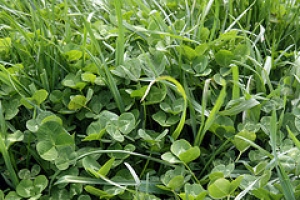Feeds for dairy cows
Developing Grass and Clover Varieties

The projects, led by IBERS are supported by LMC, AHDB-DairyCo, AHDB-EBLEX, British Grassland Society, Germinal Holdings Limited, HCC and QMS, and seek to underpin the development of new varieties of grass and clover to enhance beef, sheep and dairy production whilst reducing the environmental impact of grassland agriculture in the UK.
The four projects are concerned with more efficient utilisation of phosphorus; enhancing nitrogen use efficiency from soil to plant; increasing the efficiency with which nitrogen is used in the rumen and; developing grass and clover better adapted to the future climate of the UK. Whilst the projects still have a year to run some valuable insight has been gained from the first four years of research and a summary of the projects’ progress is outlined below:
Genetic improvement of forage grasses and white clover to improve phosphorous use efficiency (PUE) and reduce phosphorous losses to water from UK grasslands
The genetic control of phosphorus use in white clover and perennial ryegrass is now much better understood and this knowledge is being used to develop new varieties with lower P requirements. White clover varieties that perform well at moderate soil P with no added P fertiliser have been developed and will be entered for National List testing. White clover varieties from plants selected on soils with low P have been developed and will be entered for National List testing.
Genetic improvement of perennial ryegrass and red clover to increase nitrogen use efficiency and reduce N losses from pasture and silo
The genetic control of the use of soil nitrogen by perennial ryegrass is now much better understood and this knowledge is being used to develop new varieties with enhanced nitrogen use efficiency. A new low nitrate leaching line of red clover has been developed and is being grown in field experiments to compare leaching propensity over a three year period in comparison with a typical red clover variety. Variation in activity of the enzyme polyphenol oxidase (PPO), which protects protein molecules from breaking down, has been identified between and within red clover varieties which will enable selection of new red clover varieties with appropriate levels of PPO to reduce N losses.
Genetic improvement of perennial ryegrass and white clover to increase the efficiency of nitrogen use in the rumen
Three new AberHSG (High Sugar Grass) diploid perennial ryegrasses, currently undergoing National and Recommended List trials, combine the agronomic performance expected from Aber with enhanced protein use efficiency in the rumen. It is anticipated that the first AberHSG variety with this added benefit will be launched in 2014. The latest three diploid ryegrass varieties bred in 2011 at IBERS will further build on past successes plus provide even greater ruminant performance due to enhanced rumen nitrogen use efficiency. In the future this will mean more grass per kg of fertiliser plus even more meat and milk production from forage fed animals. A novel lower protein white clover has been developed and is currently being grown in field trials alongside a typical white clover to quantify impact of reduced protein content on feed intake, milk production and N excretion when fed to ruminants with high sugar grasses.
Development of productive and persistent high quality forage grasses and white clover with increased water use efficiency and resilience to summer droughts
Despite recent wet summers in Northern Ireland, rainfall in the UK is now consistently lower than the 1961- 1990 long-term average. Perennial ryegrass production is reduced by 1 tonne / hectare for every 50mm increase in soil water deficit (typically a reduction of 2-4 tonnes / ha / yr in the UK). Ryegrass x fescue species’ hybrids combine forage production and quality with persistency and stress tolerance. Italian ryegrass water-useefficiency (grams of dry matter produced per unit of water consumed) is increased significantly following the introduction of a limited number of selected genes for drought tolerance through conventional breeding from related fescue species adapted to Mediterranean conditions. New drought tolerant ryegrass provides forage production and quality equivalent to current ryegrass varieties under non-stress conditions but significantly greater yields and recovery under prolonged summer droughts.
New ryegrass x North African or Mediterranean fescue species’ hybrids are fertile and highly productive with large extensive root systems and provide potential for sustained future grassland agriculture should water availability be reduced to levels significantly greater than are found in the UK today. Variation in water use efficiency and drought tolerance within white clover is closely associated with differences in root architecture providing valuable information that will enable incorporation of drought tolerant traits into new white clover varieties. New hybrids between white clover and the rhizomatous species Caucasian clover are more drought tolerant than white clover at comparable levels of soil moisture deficit providing options for sustainable forage production in periods of summer drought.
For more information on these projects lease refer to the project website at http://www.greenergrasslands.ibers.aber.ac.uk/index.html
The Breeding LINK projects are sponsored by Defra through the Sustainable Livestock Production (SLP) LINK programme with support from AHDB-DairyCo, AHDB-EBLEX, British Grassland Society (BGS), Germinal Holdings Ltd, Hybu Cig Cymru, Livestock and Meat Commission of Northern Ireland LMC(NI) and Quality Meat Scotland (QMS).
April 2012






















